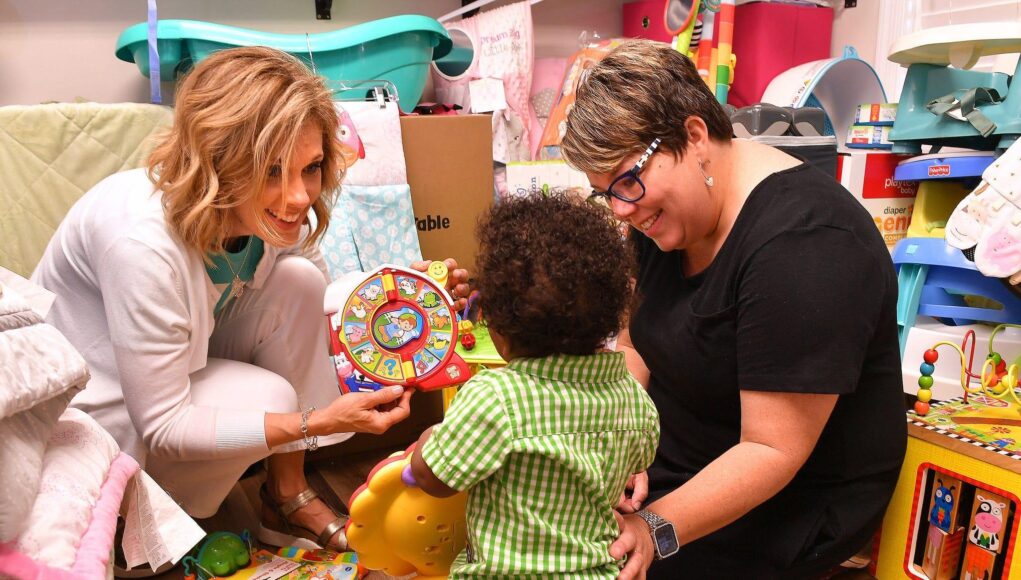WASHINGTON – Only 6% of Missouri’s three- and four-year olds are enrolled in publicly funded preschool, the lowest share in the nation.
The average cost of putting an infant in a child care center in California eats up an average 18% of household income.
And an expanded tax credit for children that President Joe Biden has included in a proposed package of education and safety-net programs for families would reduce by more than half the child poverty in Alaska, Arizona, and Oklahoma.
Those are some of the statistics in state-specific fact sheets, provided first to USA TODAY, that the administration will use to pitch its trillion-dollar plan focused on child care and education both nationally and to governors, mayors, county leaders and local groups. The Biden administration is looking to shore up support across the country for its families plan, which is expected to face a steep climb in Congress where Republicans decry it as excess government spending.
The White House saw some success in a similar effort earlier this year, when it directly pitched Americans on the $1.9 trillion COVID-19 stimulus package before passing it without Republican support.
Biden and team hit the road to make pitch for plan
The American Families Plan, as the White House calls it, is the companion to a $2.3 trillion infrastructure and jobs plan also aimed at making major investments that Democrats argue are long overdue. The $1.8 trillion package of spending increases and tax breaks would be offset by tax hikes on the richest households.
The U.S. ranks among the lowest among the wealthiest nations that offer child care benefits and paid leave benefits, which also contributes to its ranking as one of the worst child poverty rates among developed nations. The coronavirus pandemic laid bare the gaps in child care as millions of women were forced to leave their jobs and shoulder the burden at home.
But an expansion of social welfare programs is likely to be a tougher sell in the narrowly-divided Congress than Biden’s plan to increase funding for roads, broadband and water projects – areas of spending that have enjoyed more bipartisan support.
The tax increases that Biden has proposed to pay for both packages are also a non-starter for Republicans.
Senate Minority Leader Mitch McConnell, R-Ky., on Monday predicted no Republican will support the combination of plans.
“One-hundred percent of my focus is on stopping this new administration,” McConnell said Wednesday.
Biden and other top administration are traveling around the country, hitting the airways, and dialing up lawmakers to push the package.
“This will grow the economy,” Biden said Monday during a visit to a community college in Virginia. “Everybody will be better off.”
Assessments of the plan and its impacts vary
The administration got some back up for that assertion in an assessment released Tuesday by Moody’s Analytics.
Chief economist Mark Zandi and assistant director Bernard Yaros wrote that the families plan will boost the economy by increasing labor force participation and educational attainment while also addressing income inequality.
More: The child care industry collapsed during COVID-19, so Biden’s giving it $39B from the stimulus
But an analysis released Wednesday by Penn Wharton Budget Model, a nonpartisan group at the University of Pennsylvania’s Wharton School, projects the costs of Biden’s plan will exceed new revenues by 2050, causing a drag on the economy despite productivity gains.
Wharton’s Kent Smetters noted that the welfare of a nation isn’t fully captured solely by the size of the economy and people can be better off overall even if the economy is smaller than what it would be without the changes.
Still, White House press secretary Jen Psaki on Wednesday said the administration strongly disagrees with the analysis, which calculated a higher cost for the proposals than the White House factored in.
A big reason for the difference is the Wharton team used the full cost of free preschool and two free years of community college even though the administration expects states to share the tab.
“How are states going to pay for it? Are they going to increase taxes?” said Rich Prisinzano, director of policy analysis for the Penn Wharton Budget Model. “That’s all going to have an effect.”
Another costly component is an extension through 2025 of the enhanced child tax credits that were passed in Biden’s $1.9 trillion American Rescue Plan. Biden also wants to pay for child care for the neediest families and ensure that those who earn up to 1.5 times their state median income won’t have to pay more than 7% of their income on child care.
In Massachusetts, a two-parent household has to spend an average of 15% of income on care for one child, according to the White House. In Indiana, where child care is about half as expensive but incomes are lower, a household spends an average of 12% of income.
Women’s participation in the workforce is one of the lowest rates for developed economies because of the high cost of child care and of caring for other needy family members, according to Moody’s. In Massachusetts and Indiana the workforce gender gap is 23%, meaning mothers’ participation rate is 23 percentage points lower than fathers’, according to the White House.
Beyond child care, Biden wants all three- and four-year-olds to have access to free, high-quality prekindergarten, regardless of their families’ incomes.
But the White House expects states to pick up some of the cost – 10% initially and 50% eventually.
Administration officials say they’re optimistic states will want to participate in the expansion, pointing to the fact that some conservative states like Oklahoma have statewide pre-K programs. Nearly 60% of Oklahoma’s three- and four-year olds are enrolled in publicly funded preschool, according to the administration.
“Many states are investing in preschool and looking to expand access to preschool,” said Carmel Martin, White House deputy domestic policy adviser for upward mobility.
Looking to COVID package for inspiration in selling new plan
The proposed partnership is also a recognition that states and localities are needed to help drive delivery of the program.
Much like the president’s COVID-19 stimulus package, which saw broad support across the country, the administration is betting on the popularity of its families plan among voters.
A Morning Consult/Politico poll released Thursday found that 58% of registered voters say they support Biden’s American Families Plan, including 54% of independents and 25% of Republicans. Among the most popular provisions were child care subsidies for low- and middle-income workers (64%) and free pre-school (63%).
More: ‘Dinner table’ politics: Why Joe Biden ditched bipartisan dealmaking to pass his COVID-19 relief bill
More: Amid calls for unity, President Biden and Republicans don’t agree what that looks like
But a dozen states have rejected federal funding to expand Medicaid in part over ideological concerns about federal entanglement and not trusting Washington to keep its funding promise.
In addition, some states have resisted existing federal preschool grants, objecting to federal control or other issues.
The White House said states would have a big role in defining and implementing the quality standards for preschools. And if a state doesn’t participate, the federal government will try to partner with local communities.
The roll-out wouldn’t be as immediate as the COVID-19 stimulus package, which saw $1,400 checks sent directly to Americans and provided a boost in funding for state vaccine campaigns. Instead, some programs would require states to buy into programs that would be phased in over 10 years, including free pre-K and expanding access to high-quality child care, which Biden wants to also include raising employee pay to at least $15 per hour.
Martin said it may be relatively easier for some states to scale up programs like pre-school in states like Oklahoma and Georgia, where pre-K programs are already in place.
“Our cost estimates assume that full implementation will take some time, as to stand up the program and people gain awareness that the programs are available,” Martin said. “In some instances, states and local communities may need to build the capacity of the system to support all those who are eligible.”
That’s only, of course, if the proposal is enacted.
After the infrastructure and jobs package was released at the end of March, Psaki said Biden wanted to see progress by May and passage by summer. She declined, on Tuesday, to set a time frame for action on the families plan.
Biden’s American Families Plan in charts: What’s in the plan with subsidized child care and free pre-K
Thanks but no thanks: States are wary of President Joe Biden’s offer to help them expand Medicaid









